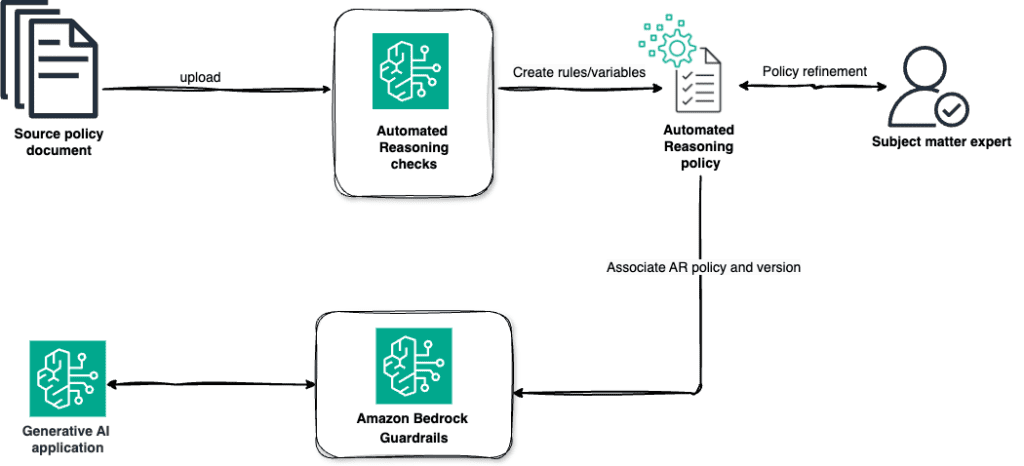Transforming AI with Amazon Bedrock’s Automated Reasoning: A Game Changer for Organizations
Foundation models (FMs) and generative AI are revolutionizing how companies operate across various sectors. According to a recent McKinsey & Company study, generative AI has the potential to add up to $4.4 trillion annually to the global economy. This growth comes from better operational efficiency, a modest rise in productivity, enhanced customer experiences through personalized interactions, and faster digital transformations.
However, businesses are hitting a snag when dealing with AI hallucinations—instances where AI generates plausible but incorrect information—especially as they transition their generative AI applications from experimental phases into full-scale production. The 2024 Gartner CIO Generative AI Survey identified three primary risks related to AI inaccuracies: reasoning errors from hallucinations (59% of respondents), misinformation from malicious actors (48%), and privacy concerns (44%).
To tackle these challenges, Amazon Web Services (AWS) introduced Amazon Bedrock Automated Reasoning checks during AWS re:Invent 2024. This feature uses logical algorithms and mathematical validation to ensure the accuracy of large language model (LLM) outputs. By validating AI-generated responses against established domain knowledge, Automated Reasoning reduces the risk of factual inaccuracies. It’s part of a larger suite of protections under Amazon Bedrock Guardrails, which also includes content filtering and personal data redaction. Collectively, these tools empower organizations to safely harness generative AI capabilities.
Understanding Automated Reasoning
At its core, Automated Reasoning leverages formal mathematical logic to verify compliance with rules and requirements, providing absolute certainty within defined parameters. Unlike machine learning’s probabilistic methods, which cannot guarantee outcomes, Automated Reasoning gives definitive responses, similar to how auditors validate financial statements.
The process relies on encoding complex rules into logical formulas and utilizing SAT/SMT solvers to determine if these formulas can be satisfied. The solvers can return one of three results:
- Satisfiable: The solver finds a combination of values that proves the formulas can hold true.
- Unsatisfiable: It concludes that no values exist, indicating conflicting constraints.
- Unknown: The solver is unable to reach a conclusion due to insufficient data.
This assurance mechanism is crucial for applications demanding unwavering accuracy and clear communication to users.
Key Features of Automated Reasoning Checks
Amazon’s Automated Reasoning checks offer several essential features that enhance the accuracy and reliability of AI applications:
- Mathematical Validation Framework: This feature utilizes rigorous logic-based deduction, providing definitive guarantees about system behaviors.
- Policy-Based Knowledge Representation: Organizations can create structured Automated Reasoning policies by coding their business rules into logical formats, enabling systematic auditing and version control.
- Domain Expert Enablement: It allows non-technical professionals, such as HR personnel, to encode their policies directly into the system, ensuring accuracy in rule representation.
- Natural Language to Logic Translation: A combination of LLMs for natural language understanding and a symbolic reasoning engine for validation ensures both accessibility and precision.
- Explainable Validation Results: Each check provides clear findings and explanations, helping users understand the results and suggesting necessary corrections.
- Interactive Testing Environment: Users can refine policies in real time through an interactive chat playground on the Amazon Bedrock console.
- Seamless AWS Integration: The checks connect effortlessly with existing Amazon Bedrock Guardrails and offer flexible implementation options via APIs.
By utilizing these features, organizations can enhance their fact-checking processes in AI applications while ensuring transparent validation steps.
Implementation: A Step-by-Step Guide
To better illustrate the application of Automated Reasoning checks, let’s consider a sample Paid Leave of Absence policy. This document outlines employee eligibility, duration, application procedures, and benefits—making it ideal to validate against AI-generated inquiries.
Initial Steps
- Access the Amazon Bedrock Console: Start by selecting "Automated Reasoning Preview" under Safeguards.
- Create a Policy: Upload the source document, such as the Paid Leave policy, and describe its intent, which could cover eligibility criteria and application questions.
- Associate Guardrails: Create and configure a guardrail on the console, integrating the Automated Reasoning policy to ensure compliance with the established rules.
Testing Your Policy
Once the policies are in place, it’s time to test:
- Simulate User Queries: Use the Amazon Bedrock testing playground to enter sample questions related to the policy.
- Analyze Results: Review the validation findings to identify whether the responses are valid, invalid, or lack sufficient data.
Continuous Improvement
Take suggestions and feedback from your validation results to refine your AI model continually. Adjust the rules and descriptions based on the validation outcomes to enhance the AI’s accuracy and robustness.
Exploring Use Cases
The potential applications of Automated Reasoning checks are vast, spanning industries from healthcare to finance. Here are just a few examples:
- Healthcare: Validate AI treatment recommendations against clinical guidelines or ensure compliance with patient education materials.
- Financial Services: Check investment recommendations against regulatory requirements and validate communication with customers.
- Travel and Hospitality: Confirm that policies on booking and ticketing are accurate and compliant with established rules.
- Insurance: Verify eligibility or claims processing decisions against policy terms.
- Manufacturing: Ensure quality control procedures comply with industry standards.
Best Practices for Implementation
To maximize the effectiveness of Automated Reasoning checks, consider these best practices:
- Prepare structured, plain language documents free of complex formatting.
- Clearly define intents for policies to capture all necessary scenarios.
- Regularly audit and test policies to maintain alignment with current operational requirements.
- Implement a feedback system to continuously enhance response accuracy.
Conclusion
Amazon Bedrock Automated Reasoning checks mark a revolutionary step forward in verifying generative AI applications. By combining stringent mathematical validation with an easy-to-use interface, this feature addresses one of the most pressing challenges in AI deployment: ensuring accuracy and minimizing errors.
As businesses continue to integrate generative AI, automated validation will prove crucial for developing reliable applications. We invite organizations to explore Amazon Bedrock Automated Reasoning checks, enhancing their AI capabilities while adhering to industry standards.
The AI Buzz Hub team is excited to see where these breakthroughs take us. Want to stay in the loop on all things AI? Subscribe to our newsletter or share this article with your fellow enthusiasts.




